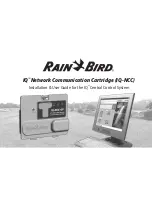
Instructional Booklet
Page
12
Effective: March 2021
Operation and Maintenance Manual,
Automatic Transfer Switch Controller, ATC-900
For more information visit: www.eaton.com
IB140012EN
Section 3: Operator Panel and Display Menus
3.1 General
The operator panel, which is normally accessible from the outside
of a panel or door, provides a means for being alerted to specific
conditions, receiving functional help, programming, and parameter
monitoring/selection (Figure 1). For the purpose of familiarization,
the panel is divided into three sub-sections and discussed individu-
ally:
•
LEDs
•
Pushbuttons
•
Color Display Window (not a touch screen).
3.2 LEDS
LEDs are used to indicate the device’s mode of operation, the status
of the system, and the operations and/or conditions of displayed
functions. The LED at the top of the ATC-900 provide a quick snap-
shot of the unit’s status (Mode). Six LEDs, just above the display
window, indicate which portions of the mimic bus are active, and
the actual status of both sources and load.
Unit Status LED
This LED blinks green indicating that the ATC-900 is operating
and providing the transfer switch control function in keeping with
programmed setpoints. If the LED is not lit or is on continuously, a
problem may be indicated.
Source 1 Available - Status LED
This LED is lit white if Source 1 meets the criteria for programmed
Source 1 setpoints.
Source 1 Preferred - Status LED
This LED is lit Green if Source 1 is the preferred source choice.
Source 1 Connected - Status LED
This LED is lit green if Source 1 is connected. This is accom-
plished by sensing the Source 1 breaker/contactor via the S1
closed auxiliary contact.
Source 2 Available - Status LED
This LED is lit amber if Source 2 meets the criteria for pro-
grammed Source 2 setpoints.
Source 2 Preferred - Status LED
This LED is lit green if Source 2 is the preferred source choice.
Source 2 Connected - Status LED
This LED is lit red if Source 2 is connected. This is accomplished
by sensing the Source 2 breaker/contactor via the S2 closed auxil-
iary contact.
3.3 Pushbuttons
The front operations panel supports seven blue membrane push-
buttons. Pushbuttons accomplish their function when pressed and
released. Certain pushbuttons, like the up, down, left, and right
Arrows, will also continue to scroll if they are pressed and not
released.
3.3.2 Help Pushbutton
When the Help pushbutton is pressed and released with the
ATC-900 in any mode, the display will show a message. Mes-
sages and explanations relative to what is being viewed in the dis-
play are intended to prompt and assist the operator.
Pressing the Help and Enter pushbutton at the same time will
allow the user to bypass the timers including Time Delay Normal
to Emergency, Time Delay Emergency to Normal, Time Delay Neu-
tral, and Engine Cooldown.
3.3.3 Engine Test Pushbutton
A self test is initiated when the Engine Test pushbutton is pressed
and the controller password is entered. Pressing the Engine Test
pushbutton again while in the engine run condition aborts the test.
Upon test initiation, a generator start of the non-preferred source is
engaged after the Time Delay Engine Start timeout. If a full test is
programmed, a transfer with all programmed times occurs. The
ATC-900 includes a unique set of independently programmable time
delays activated during a test. The test engine run timer will hold the
load for the required timeout and the test is concluded with a re-
transfer cycle. For an engine run only test, no transfer will occur and
the engine will run for the programmed run time.
3.3.4 Enter Pushbutton
The Enter pushbutton allows the user to select different areas of
the display after arrow buttons move to the area of need.
3.3.5 Up, Down, Left, and Right Arrow Pushbuttons
These pushbuttons are used for system navigation through
menus. They are also used when selecting and changing set-
points. They may be pressed and released for step-by-step
changes or held down for continuous scrolling..
NOTICE
WITH RESPECT TO THEIR USE IN THIS DOCUMENT AND AS THEY
RELATE TO AUTOMATIC TRANSFER SWITCH OPERATION, THE
WORDS “CYCLE” AND “EVENT” ARE DEFINED AS FOLLOWS:
CYCLE – A COMPLETE OPERATION FROM NORMAL TO EMERGENCY
TO NORMAL.
EVENT – A FAILURE RESULTING IN SOME TYPE OF SWITCH AND/OR
SWITCH INTELLIGENCE ACTION.
NOTICE
REFER TO SECTION 3.4 FOR AN OVERALL VIEW OF ATC-900’S
MENU TREE.
NOTICE
THE OPTIONAL PLANT EXERCISER FEATURE ALLOWS FOR AUTO-
MATIC PROGRAMMING OF THE DESIRED TEST CYCLE ON A SCHED-
ULED BASIS. IF THE SWITCH IS UNABLE TO PROCESS EITHER A
PLANT EXERCISER REQUEST OR THE ENGINE TEST PUSHBUTTON
ITSELF DUE TO TRANSFER SWITCH STATUS, THE REQUEST IS
IGNORED.













































